This article exists to satisfy (and hopefully inspire) curiosity. Most information found in this article is not necessary to learn how to play.
Hanafuda
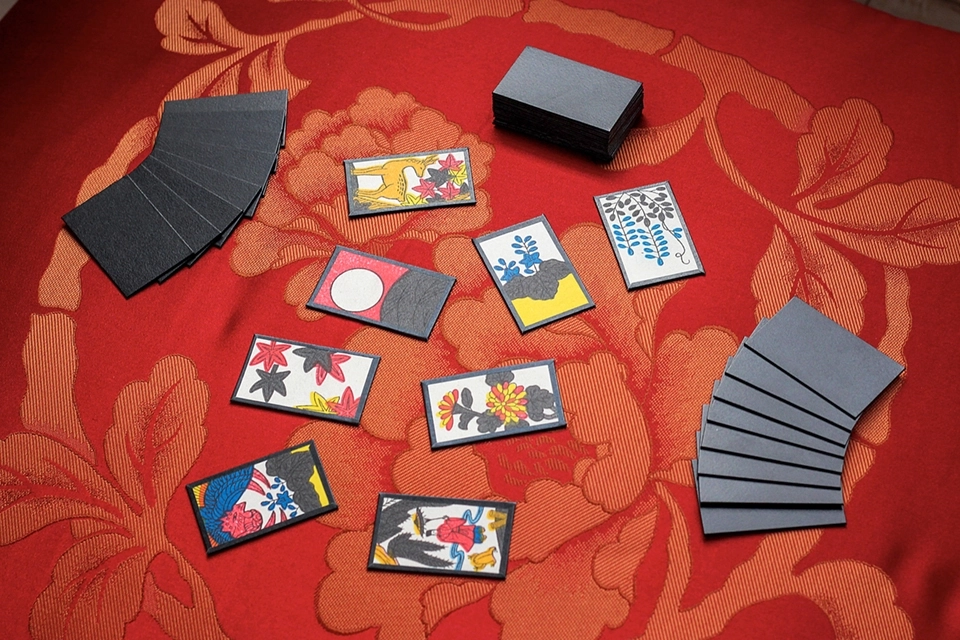
Hanafuda 花札 ▶ flower cards are Japanese playing cards that can be used to play many different games.
In Korean, these cards are known as hwatu 화투 ▶ flower fight.
#History
In the mid-1500s, Portuguese traders introduced playing cards to Japan. Portuguese decks contained 48 cards, with 12 ranks and 4 suits. Though early Japanese karuta かるた ▶ cards emulated this structure, additional styles of cards were subsequently invented.
One of these styles was hanafuda, which has 12 suits and 4 ranks, inverting the structure from most Western cards.
Was hanafuda invented because of gambling restrictions placed on karuta? Maybe. But there’s not enough evidence to support that claim.
#Cards
There are 48 cards in hanafuda, depicting the flora and fauna of Japan. The 12 suits in hanafuda are also referred to as months. Each is represented by a flower or plant and features a different distribution of ranked cards from each other.
Ranks
- Hikari 光 ▶ light are the highest value cards, and represent significant Japanese cultural elements, stories, and traditions.
- Tane 種 ▶ subject cards mostly illustrate wild animals. ?
- Tanzaku 短冊 ▶ paper strip cards have three varieties: poetry, blue, and plain. People write wishes during tanabata matsuri 七夕祭り ▶ star festival, and hang them on bamboo branches.
- Kasu カス ▶ scrap are the lowest value cards. They portray various flowers and plants found in Japan.
Point Values
Hikari are worth 20 points each, Tane are 10 points, Tanzaku are 5 points, and Kasu are 1 point. The total value of the deck is 264 points. However, some games ignore point values (like Koi-Koi) or have their own (like Sakura). ?
In a famous 3-player game called Hachi-Hachi 八八 ▶ eighty-eight, each player aims to score at least 88 points (one-third of the deck value).
| Suit / Month | Hikari | Tane | Tanzaku | Kasu |
|---|---|---|---|---|
 January |
 Crane |
 Poetry ? |
  Pine | |
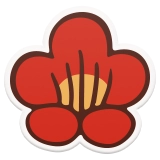 February |
 Warbler |
 Poetry ? |
  Plum Blossom | |
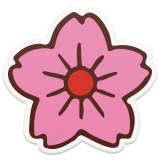 March |
 Curtain |
 Poetry ? |
  Cherry Blossom | |
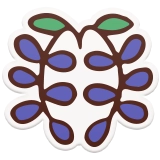 April |
 Cuckoo |
 Plain |
  Wisteria | |
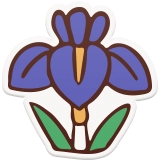 May |
 8-Plank Bridge ? |
 Plain |
  Iris | |
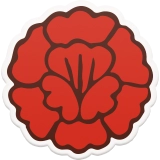 June |
 Butterflies |
 Blue |
  Peony | |
 July |
 Boar |
 Plain |
  Bush Clover | |
 August |
 Moon |
 Geese |
  Silvergrass | |
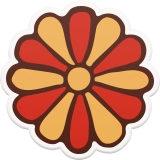 September |
 Sake ? |
 Blue |
  Chrysanthemum | |
 October |
 Deer |
 Blue |
  Maple | |
 November |
 Ono no Michikaze |
 Swallow |
 Plain ? |
 Willow ? |
 December |
 Phoenix |
   Paulownia ? |
#Details
Tane
Though not all Tane cards follow this scheme, the subject matter seems to be modeled after kachō-ga 花鳥画 ▶ bird-and-flower paintings.
- The May Tane card features yatsuhashi 八ツ橋 ▶ 8-plank bridge. Perhaps to make this card fit in better with other Tane cards, Matsui Tengudō added fireflies on the Iris leaves.
- The September Tane card depicts a sake cup with the character for kotobuki 寿 ▶ congratulations, long life.
Tanzaku
In hanafuda, Poetry Tanzaku have simple words written on them.
- Akayoroshi あかよろし ▶ red is good on the January and February Tanzaku means these cards are valuable.
- Miyoshino みよしの ▶ beautiful Yoshino on the March Tanzaku is the name of a town famous for Cherry Blossoms of the same name.
- The November Tanzaku is the only Tanzaku without small dots. This card is often excluded from Tanzaku Yaku in some games.
Kasu
Generally, Kasu cards depict a plant or flower with a significant amount of white space, though some differ in style from the others.
- The November Kasu card typically depicts a lightning storm with a red sky and thick willow branches. It is sometimes used as a Wild card. In some decks, the lightning card features Raijin 雷神 ▶ god of thunder.
- The yellow-shaded December Kasu card is stylistic, functions as a normal Kasu card, and usually displays the brand name. In some games, it could be used as an additional Tanzaku or Tane card.
#Extra Cards
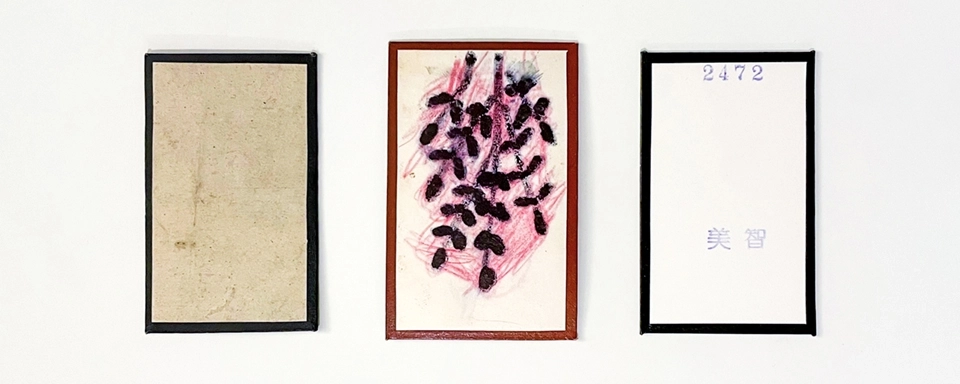
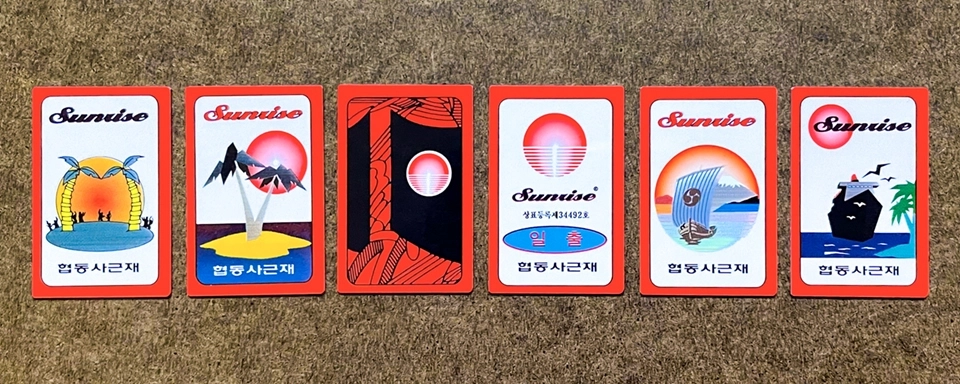

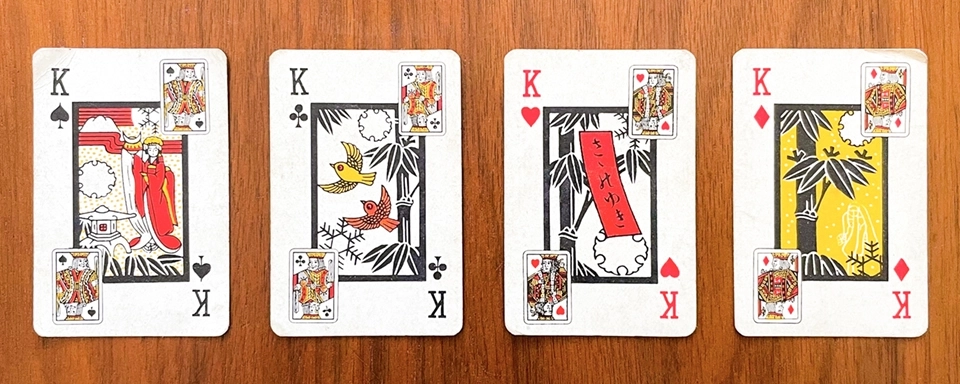
Most decks of hanafuda include one shirofuda 白札 ▶ white card. It can be used to draw a replacement, or it could have a printed serial number.
In Korean hwatu, it is common to see 6 extra cards for Go-Stop, used for optional game mechanics. These cards are often stylistically different, complete with manufacturer logos.
In hybrid decks where Ace through Queen cards double as months (January to December), Kings often display related game accessories.
Extra Suits
With the inclusion of additional suits, decks can more easily accommodate 4 players in a game similar to Hachi-Hachi (which supports 3 players).
One particular hybrid deck from The Universal Playing Card Company used King cards as a 13th hanafuda suit ( Snowy Bamboo).
The total point value of all cards in this deck (304) divided by 4 players is 76 points per player, assuming the yellow-shaded December Kasu card acts as a Tanzaku card. ?
| Suit / Month | Hikari | Tane | Tanzaku | Kasu |
|---|---|---|---|---|
 Kings / 13th Month |
 Princess Yaegaki |
 Sparrows |
 Poetry ? |
 Snowy Bamboo |
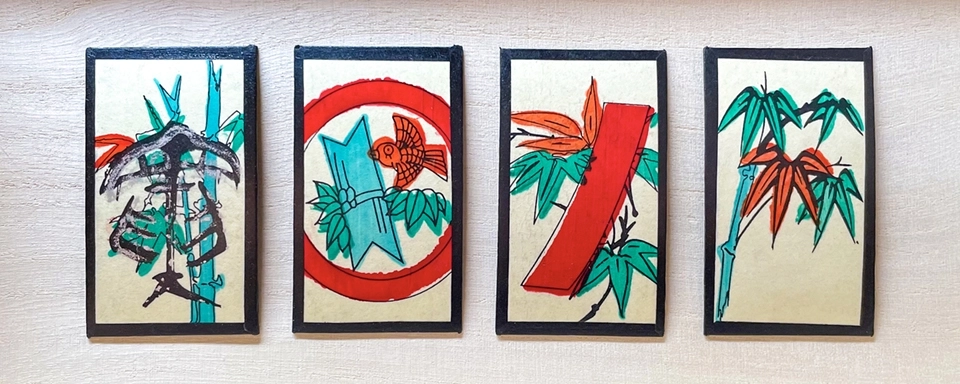
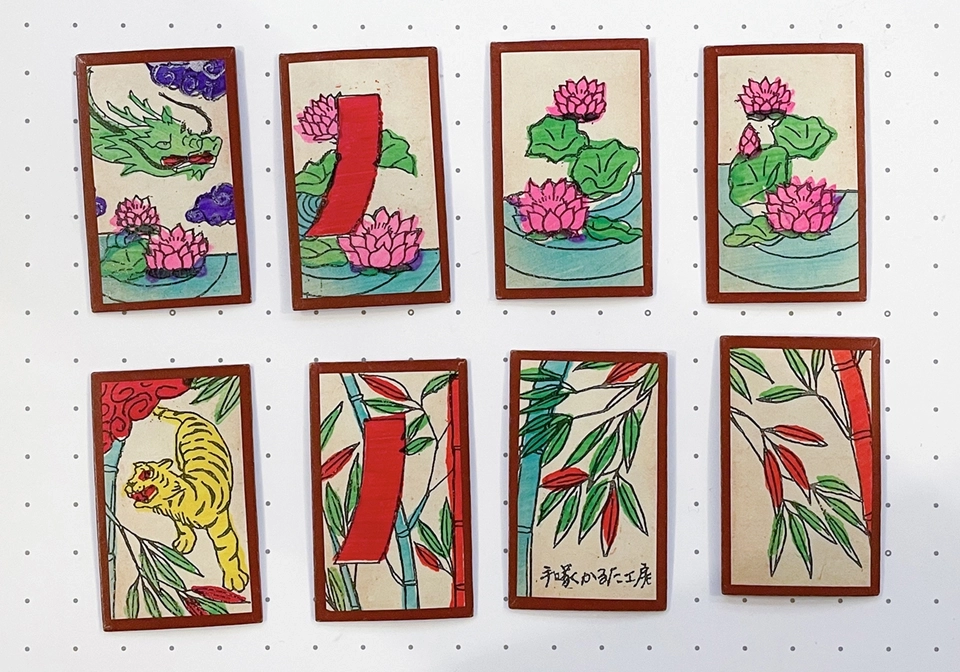
Matsui Tengudō produced two decks with additional suits. The first deck had 52 cards, which included a 13th suit ( Bamboo).
In that deck, one August Kasu and one December Kasu are shaded red and are scored like Tanzaku cards. The deck total is 308 points, 77 points per player for a 4-player game.
A later 56-card deck included two new “months,” a 13th suit ( Bamboo) and a 14th suit ( Lotus). This particular arrangement allowed for a 4-player game with a target score per player of 77 points, all without repurposing any cards from the standard deck.
| Suit / Month | Hikari | Tane | Tanzaku | Kasu |
|---|---|---|---|---|
 13th Month |
 Tiger |
 Sparrow |
 Plain |
 Bamboo |
| Suit / Month | Hikari | Tane | Tanzaku | Kasu |
|---|---|---|---|---|
 Earth |
 Tiger |
 Plain |
  Bamboo | |
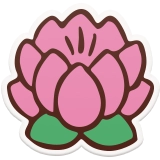 Heaven |
 Dragon |
 Plain |
  Lotus |
#Games
Hanafuda can be used to play many games, including:
- Go-Stop
- Hachi-Hachi 八八 ▶ eighty-eight
- Hana Awase 花合わせ ▶ flower matching
- Koi-Koi こいこい ▶ “Come on!”
- Sakura 桜 ▶ cherry blossoms
For printable instructions on how to play games with these decks, visit Junior’s How to Play page.
#Brands
Japanese
- Nintendō 任天堂
- Matsui Tengudō 松井天狗堂
- Ōishi Tengudō 大石天狗堂
- Tamura Shogundō 田村将軍堂
Western
#Related
See Also
References & Further Reading
- Ebashi, Takashi Hanafuda, 2014
- Ebashi, Takashi Gallery of Traditional Hanafuda
- Pollard, George The History & Art of Hanafuda on Ways to Play
- Pollard, George Traditional Hanafuda Brands on Ways to Play
Some information in this article is the result of original research. If you have questions or want to know more, join the Hanafuda Discord server.